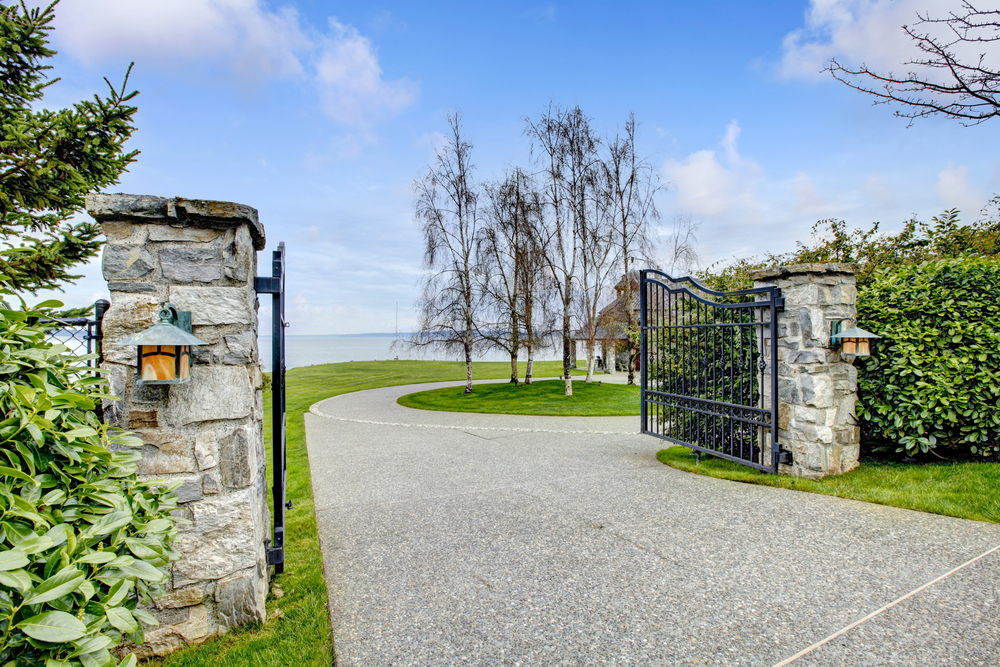Driveway gates typically swing inwards, though in some specific circumstances it may make sense for them to swing outwards.
In this article we’ll examine why driveway gates normally swing inwards, together with those situations where gates that swing out might make more sense.
We’ll also give some handy pointers on what to consider when deciding whether inward-swinging or outward-swinging driveway gates make more sense for your situation.
And lastly we’ll look at a few alternative driveway gate options that you might not have considered yet, but which might suit your needs even better.
Driveway Gates Swinging In our Out: Factors to Consider
Contents

There are a number of elements that you should consider whether it comes to how your driveway gates swing. Fortunately these can be condensed down to four broad categories. This ultimately makes it quite simple to decide on how your gates should swing.
Public Safety
A swinging gate can represent danger to pedestrians and other drivers, not to mention yourself and your family. It goes without saying that the bigger and heavier the gates, the greater the danger posed.
One reason why most driveway gates swing in – that is onto your property rather than out onto the road – is to prevent the risk of them hitting other vehicles or passing pedestrians. This is especially important if you’re planning electric swing gates, which can open with some force.
Even putting aside this danger, you won’t want your gates to swing open in such a way as to obstruct any roads or footpaths. In some areas this is a legal requirement, as well as a public-spirited decision.
Outward-swinging gates are therefore most suitable for homes that have a decent amount of driveway between the gate and a public road. The gates can swing into this gap, while still being fully on your own property.
Sadly, many of us do not have the luxury of such a long driveway, or would rather position the gates at the very end of our driveway, rather than partly along it. For this reason, gates that swing inwards are generally preferable.
Drive Space
By their very nature, swing gates need to swing to open. Depending on the width of your driveway, this can use a surprisingly large amount of space.
When deciding on whether your gates should swing in or out, the layout of your driveway is therefore a further consideration. Most importantly, is there enough space on your driveway for the gates to comfortably open inwards while still leaving enough space for your vehicle(s)?
In essence your driveway will need to be at least the length of your car(s) *plus* the width of the gate to provide suitable swinging space. In rural areas this often presents no real issue, but in more urban areas where space can be limited this may be a limitation.
Local Weather Conditions
It’s all well and good to install new driveway gates at the height of summer, but even when the sun is beating down it is important to consider winter weather.
There are two elements to consider here. Firstly, does your local area experience heavy winds on a regular basis? If so, it can make sense to position your driveway gates in such a way that the wind pushes them shut, rather than attempting to force them open.
The last thing you want is a gate being blown open in high winds and knocking into your vehicle that you absent-mindedly parked a little too close to.
Snow is another major consideration. In wintery weather it is quite common for snow to settle in drifts against driveway gates. This is most common on the outside of the gate, which is typically more exposed to the elements.
Driveway gates that swing in are essentially moving away from the snow drift so they can be more practical. In contrast, gates that swing out may get stuck on snow drifts, requiring clearing before you can safely exit your property.
Topography
One of the most commonly overlooked elements when deciding whether your gates should swing in or out is the local topography. Put simply, is your driveway on any part of a slope, or is the land perfectly flat?
If your driveway is perfectly flat then your gates could in theory open in either direction. However where a slope is present, this may cause issues with gate opening.
Imagine, if you will, a driveway that slopes sharply up towards a property. Attempting to fit inward-swinging gates here would be very difficult as they’d be at constant risk of dragging on the incline. And that assumes the incline isn’t so great that it completely prevents the gate from opening at all. In this case an outward-swinging gate might make far more sense.
Note that it’s not just steep inclines (or declines) that can affect your decision about gate direction. If the gate is large enough then even a minor slope can have an impact, so prepare to get your spirit level out to check the driveway before committing.
One Large Gate or Two Smaller Swing Gates?
A related topic for your consideration is whether one gate or two makes more sense? Some of the issues outlined above can be offset somewhat by considering a pair of gates rather than just one large gate.
For example, we mentioned that you’ll need enough driveway space not only for your car, but also for the gate to swing open into it. Fitting two gates rather than one, however, means only half the amount of space will be needed to open the gate.
This can quickly change the equation, making a swing gate a perfectly valid option where previously it seemed impossible.
What is the Alternative to Swing Gates?
Swing swing gates are arguably the most popular type of driveway gate, they’re far from the only option. Depending on your situation these alternatives might actually be more practical.
Sliding Driveway Gates
Rather than swinging open and shut, a sliding driveway gate slowly slides sideways to permit access. This completely does away with any worries about whether a gate should swing or out.
It also removes the risk to pedestrians or other car drivers as the gate itself stays entirely on your own property. They also look incredibly nice, and can be fitted on shorter drives that lack the space for a swing gate to open.
The key consideration when it comes to sliding driveway gates is of course the space you have either side of your driveway. The gate will need to slide sideways out of the way, which requires considerable space to the side of the gate post. Sliding gates like this are therefore most suitable for those with wide driveways or a decent width of land into which the gate can retreat.
Folding Driveway Gates
Folding driveway gates are typically pricier than the previous two options, but worth it for many people due to their practicalities.
As the name suggests, rather than swinging open these gates open by folding up – concertina style. Each gate closes into two or more sections. The number of folding sections will depend now only on the size of the space you’re trying to block off but also the available space on your driveway.
This folding action can save a huge amount of space, making automatic driveways gates a real possibility for people who previously thought them out of the realm of possibility.
Conclusion
In conclusion, driveway gates normally swing in rather than out, for a variety of practical (and sometimes legal) reasons.
However in some special circumstances there is a legitimate argument for driveway gates that swing outwards. Only you can decide which option works best for your unique circumstances based on the thinking points outlined above.
In situations where neither option quite meets the right balance of appearance and practicality, there are fortunately some other options. In this way almost any driveway can be protected from unwanted access and extreme weather by one or more well-considered gates.
